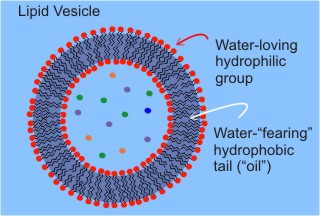Can These Bones Live? This is the question posed in Chapters 10 and 11 of Alister McGrath’s book A Fine-Tuned Universe: The Quest for God in Science and Theology where he gives a brief overview of the chemical requirements for the origin of life.
There are two facets to this discussion.
The first is really a continuation of the general observation of fine-tuning in the universe. Life as we know it requires (1) the intrinsically flexible chemistry of Carbon, with Oxygen, Nitrogen, and Phosphorous also thrown into the mix and (2) the unique properties of liquid water (H2O). The presence of these elements and the presence of a water layer on earth arise from the fine-tuning of the primitive universe to produce the right chemical elements and the right environments.
But these building blocks – the chemical elements – are not the biggest
mystery. The more profound questions involve the emergence of life –
the origin of self-replicating molecules that lead to the formation of
humans capable of abstract reasoning, creative thought, and love. The second facet to McGrath’s discussion of fine-tuning is the complex question of the development of life
from the primordial soup of chemical precursors. This is an enormous
puzzle and McGrath only sketches the tip of the iceberg.
Ah, … but before we ponder this we must consider, with McGrath,
What is life? When can an ensemble of molecules, comprised of atoms, themselves composed of elementary particles, be said to be “alive”?
On the most elementary level life consists of an enclosed system capable of metabolism and reproduction – although the later needs some nuance. So a discussion of the origin of life must consider these elements.
McGrath suggests that “life could be defined as a “self-sustaining chemical system,” able to transform resources into its own building blocks, that is “capable of undergoing Darwinian evolution.”
Once a self-replicating cell is produced evolution by natural selection provides a mechanism to introduce variation and complexity, but
evolution provides no mechanism for formation of the first cells. There are several complex questions in the formation of life, more than I can list in a simple blog post. But we can consider three as examples of the kinds of questions faced.
1. The synthesis of the fundamental organic building blocks, the molecules of life. But cosmic organic chemistry is relatively common – spectroscopic measurements have identified many of organic molecules in space, meteorites and comets have provided more evidence. The evidence includes the formation of many simple compound, but also more complex and fundamental molecules, including amino acids – the building blocks of proteins.
The evidence of this comes from … and the detailed chemical analysis of meteorites that have fallen to Earth, such as the famous Murchison meteorite of 1969. … The Murchison meteorite, for example, was found to contain certain common amino acids such as alanine, glycine, and glutamic acid, in addition to more unusual ones such as isovaline and psuedoleucine. These could not be due to terrestrial contamination as a result of the impact of the meteorite. (pp. 134-135)
The Wikipedia article appears to give a balanced account of this meteorite. There is some evidence for terrestrial contamination but there also seems to be clear evidence for extraterrestrial formation of amino acids. The famous Miller-Urey experiment also demonstrated the formation of complex organic molecules under conditions potentially similar to those of the early earth. All these experiments or discoveries demonstrate is that organic chemistry is robust and that amino acids are stable and kinetically favored under a range of conditions.
2. The synthesis of an information carrying molecule. It is widely believed that RNA (ribonucleic acid) filled this function initially. RNA is capable of a multitude of functions – it can carry information, it can self-assemble and self-replicate, it can act as a catalyst – a ribozyme, it can synthesize proteins (which are even better catalysts – enzymes), and eventually it can modify to produce DNA (deoxyribonucleic acid). But there is no consensus on how the synthesis of nucleotides from prebiotic presursors came about – no known reactions appear capable of this synthesis. Research is ongoing.

3. Develpment of contained organisms. The transition from “chemical soup” to life requires more than nucleic acids and amino acids however. It requires the formation of a protoorganism. “This “protoorganism” can be thought of as a single cooperative aggregate consisting of a protocontainer, a protometabolism, and protogenes.” (p. 137) Here we really get into the importance of the unique properties of water as the biological solvent. Water enables complex acid-base equilibria, it dissolves polar molecules and excludes non-polar (think of the separation of oil and water). Lipids have nonpolar tails and polar headgroups combined in one molecule. In water these spontaneously form vesicles – rudimentary “cell membranes.” Water supports complex chemistry and the formation of complex structures. It is speculated that a protoorganism could form from lipid vesicles in water encapsulating RNA and other simple molecules.
Can we see the hand of God in this process?
It must be admitted that we have no firm ground for speculating on the mechanism for the initial formation of life at the present time. Science continues to progress however, and perhaps we will have a viable explanation, sooner rather than later. On the other hand, a natural explanation doesn’t negate the presence of fine-tuning in the universe, or eliminate the hand of God in the process. And here we (and McGrath) return to Augustine.
It will also be clear that Augustine’s notion of rationales seminales plays an important heuristic role in engaging with the complex chemical phenomena that have briefly been described in this chapter. The emergence of chemical complexity precedes that of biological complexity and is generally ignored in accounts of biological evolution. Yet the importance of this point is clear: without an inherent capacity for chemical complexification, the foundations for biological development would not have been in place. These chemical properties must be regarded as emergent. Augustine’s image of the dormant seed, awaiting the right conditions for germination, is a helpful analogue for understanding how certain chemical properties emerge under appropriate circumstances.
… On the basis of known biochemical systems, biological evolution remains dependent upon chemical properties which were ultimately determined in the primitive state of the universe. (p. 142)
What do you think – What constitutes life? What role do you think that God played in the formation of life? Did he embed a seed in the big bang or did he play a more personal role guiding and directing the process?
If you wish to contact me directly you may do so at rjs4mail [at] att.net.

